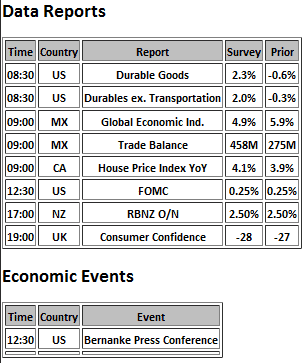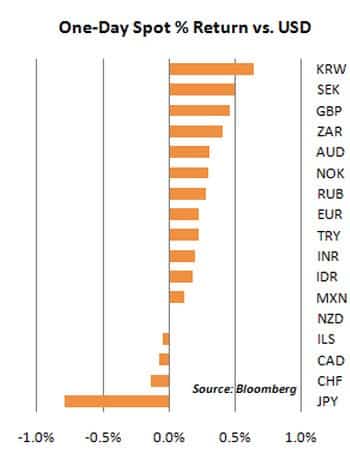Meet the Press, Mr. Bernanke
BBH CurrencyView
- Dollar continues weak leading up to FOMC announcement and press conference
- Risk appetite continues strong, AUD moves to new highs assisted by inflation data
- S&P changes outlook to negative on Japanese sovereign credit
The US dollar continued to weaken for the seventh consecutive day, with the dollar index hitting its lowest level since August 2008, ahead of the today’s FOMC meeting. In our view the Fed is likely to reaffirm its ultra-accommodative policy, which has kept up interest in higher yielding currencies, with most of the dollar bloc currencies hitting fresh multi-year highs. Continued evidence of inflationary headwinds in the euro zone, in turn, drove the euro to push through 1.47, while sterling surged after UK Q1 GDP rebounded 0.5%, adding marginal support for an August rate hike. The MSCI Asia Pacific index pushed 0.1% higher and European stocks rose for a fifth day, boosted in part as earnings exceeded analysts’ expectations, which is likely to lead to a strong opening in New York. Against this backdrop, bonds are heavy with marked selling in the belly of most sovereign curves, although short-term bunds are outperforming as periphery spreads continue to blow out. Elsewhere, commodities are firm with crude up 0.3% while base metals are soft, with copper down for a second day, on demand worries.
The FOMC news today will be in the statement and Bernanke’s first press conference. As rates will remain unchanged, QE II is a topic to be watched. Despite comments by some governors about an early termination, none have dissented on QE II at meetings this year, and the Fed will complete its purchases. Questions regarding principal repayments/the Fed’s balance sheet after completion may be addressed, but our understanding is that over the next few quarters, there are not a lot of maturing Treasuries among the Fed’s holdings. Other comments to watch are on the economic recovery, where the Fed is likely to acknowledge a moderation in pace, and any change to conditions warrant maintaining low yields for an extended period of time, which we expect to remain unchanged. The announcement time is moved up to 12:30, followed by the press conference at 2:15. While the conference may add some short term volatility, for the most part we expect it to be not much of a change, adding visibility but not much in transparency. Today’s UK Q1 GDP, as expected at +0.5%, offsets the prior quarter’s contraction, for a net zero growth rate for the past 6 months. At 1.8% yoy, growth is below government projections, and this data should reinforce market doubts about the timing of the BOE’s rate normalization policy. That said, GBP is up 1 cent to 1.6570, but we expect gains from this news to be transitory. S&P today changed its outlook on Japan’s credit rating, AA-, to negative, and Moody’s reaffirmed its negative outlook as well. The rating agencies will not resolve this question until after the reconstruction package passes the Japanese parliament, expected in June. USD/JPY strengthened to 82.20 on the news, but will find resistance at 82.60.
The Australian dollar reached new 29-year highs against the dollar after stronger-than-expected Q1 CPI figures reinforced H2 RBA rate hike expectations. Overall, the sizable gains in core CPI suggest that Q4 was the low point for underlying inflation and that pressures will build through the rest of the year. As a result, this report adds to the backing for a return to rate hikes in H2 of this year. Underlying inflation growth on an annual basis gives the RBA ample leeway to maintain current rates through mid-year. Indeed, overnight OIS swaps only imply a tightening of 25bps in the overnight rate over the next year, which suggests in our view that the market may be under-pricing inflation risks and therefore rates might have further room to rise. A basic Taylor model framework would also indicate that rates should be higher as well. As such, AUD rallied to 1.0850, driven by a combination of reinforced expectations of an H2 rate hike and strong risk appetite. Elsewhere, in the dollar bloc the New Zealand dollar rallied to a 30-month high of 0.8110 driven in part by a strong business confidence print and the strength in risky assets as it is likely today that the Fed affirms its accommodative policy stance. Yet, ahead of the RBNZ meeting we view the risks for the kiwi the downside and would recommend selling into today’s rally, as the RBNZ is likely to suggest that the current accommodative posture is likely to remain in place for the foreseeable future. On the whole, a ultra-accommodative Fed this afternoon is likely to prompt the AUD/USD to test the 1.09 area, while the NZD/USD is likely to retreat ahead of 0.81.


Comments are closed.